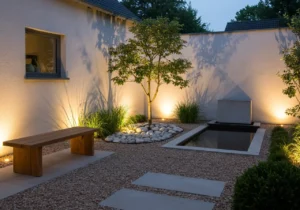Life often feels like a whirlwind, doesn’t it? We juggle work, family, and endless to-do lists, constantly seeking a moment of calm. I know that feeling all too well. For years, I searched for little pockets of peace within my home, and then I discovered the incredible power of a Zen garden. It’s more than just a decorative feature; it’s a living, breathing space designed to bring tranquility right to your doorstep. Whether you have a sprawling backyard or a tiny desk nook, the principles of a Zen garden can transform your surroundings into a haven of serenity. Join me as I share 14 Zen garden ideas that have personally helped me find moments of stillness amidst the everyday chaos, proving that peace is truly within reach.
Craft Your Miniature Zen Garden Oasis
One of my favorite discoveries was how accessible Zen gardens truly are. You don’t need a huge outdoor space to create a calming retreat. I started with a small tabletop version, and it quickly became my go-to for a quick mental reset during a busy day. It’s amazing how a few simple elements can transform a corner of your home into a personal oasis. Crafting your miniature Zen garden oasis allows you to bring the essence of tranquility into even the smallest living areas.
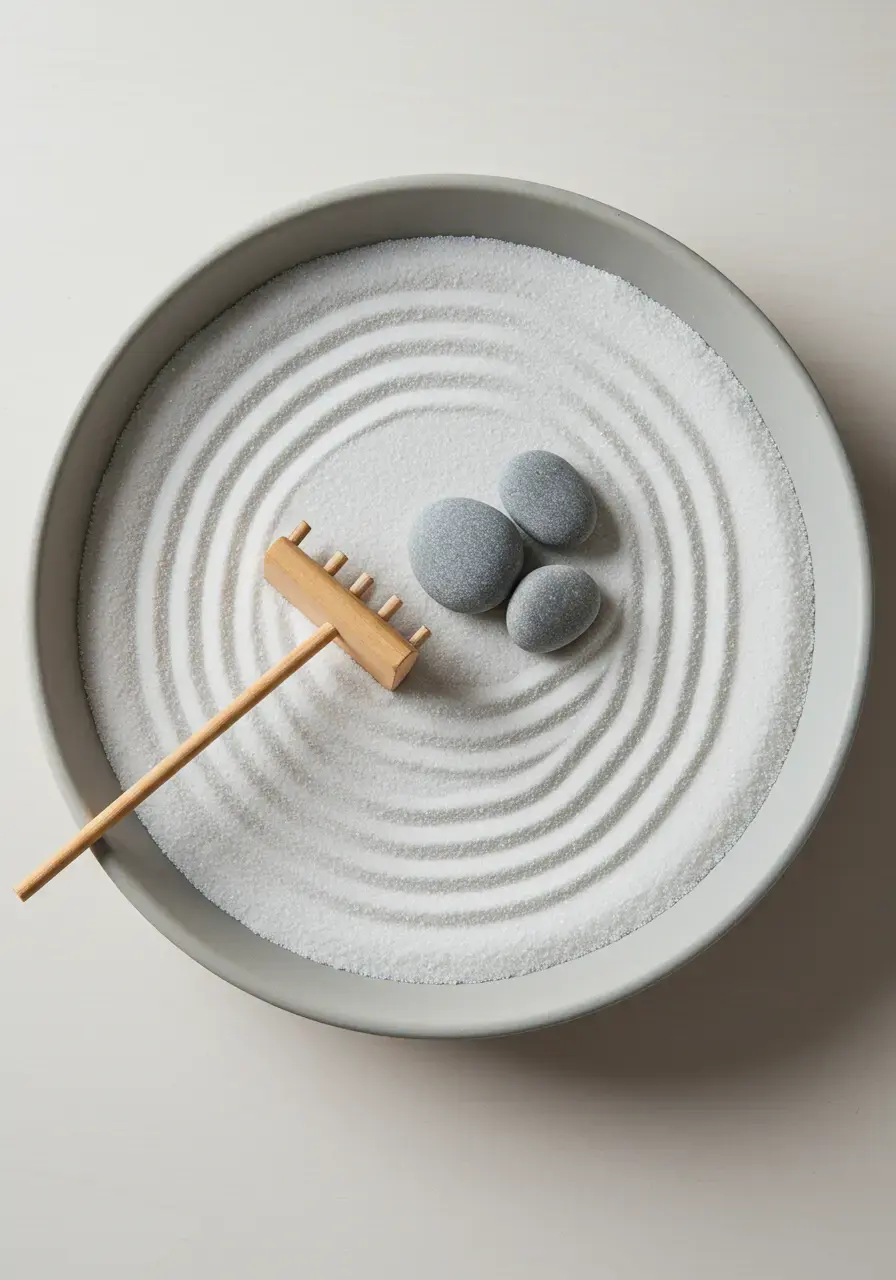
Why This Works:
This idea works because it offers an immediate, hands-on way to engage with the principles of Zen without needing significant space or resources. It promotes mindfulness and provides a portable source of calm, making it perfect for an apartment or a busy office desk.
How You Can Recreate It:
- Gather a shallow tray or decorative bowl as your base.
- Fill it with fine sand, preferably white or very light in color.
- Add a few smooth, small stones and a miniature rake for creating patterns.
Incorporate Water Features in Your Zen Garden
The sound of water has a magical quality for me. It’s incredibly soothing and grounding. When I first added a tiny water feature to my outdoor Zen garden, I noticed an immediate shift in the atmosphere. The gentle trickling became a natural soundtrack for reflection. Incorporating water features in your Zen garden amplifies the sense of peace and brings an auditory layer of tranquility that’s hard to beat.
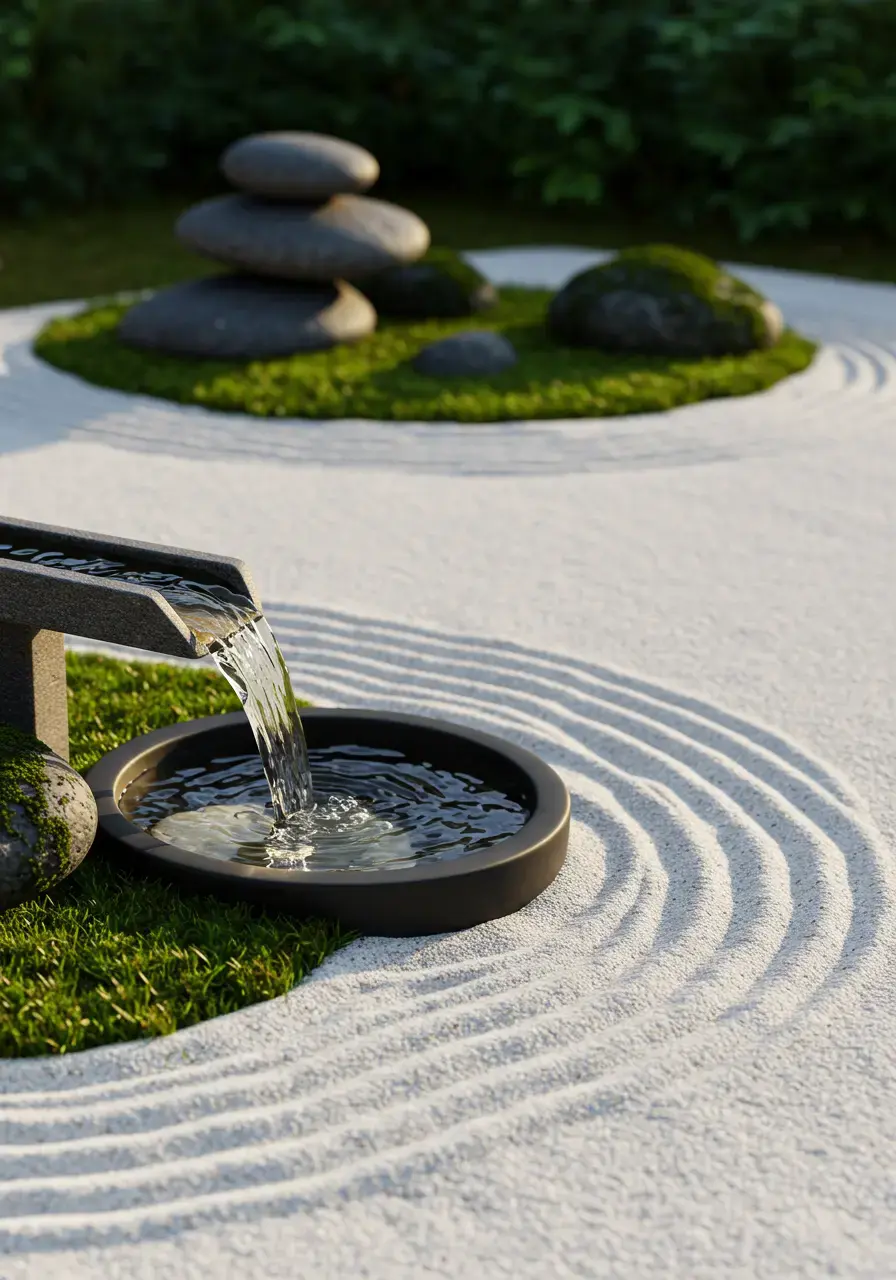
Why This Works:
Water features add a vital auditory element to your Zen garden, creating calming sounds that mask urban noise and promote relaxation. The visual movement of water also adds a dynamic, living quality to the static elements of sand and stone, enhancing the overall sensory experience.
How You Can Recreate It:
- Choose a small, self-contained water pump or fountain designed for garden use.
- Position it thoughtfully so the water flows peacefully over stones or into a basin.
- Ensure the size and sound level are proportionate to your garden’s scale; you want gentle trickles, not a roaring cascade.
DIY tabletop Zen Garden Ideas
I’m a big believer in the power of DIY. There’s something incredibly satisfying about creating something beautiful with your own hands. My first tabletop Zen garden was a weekend project, and it taught me so much about simplicity and focus. DIY tabletop Zen garden ideas are perfect for those who want a personalized touch and enjoy the process of making their own calming space.
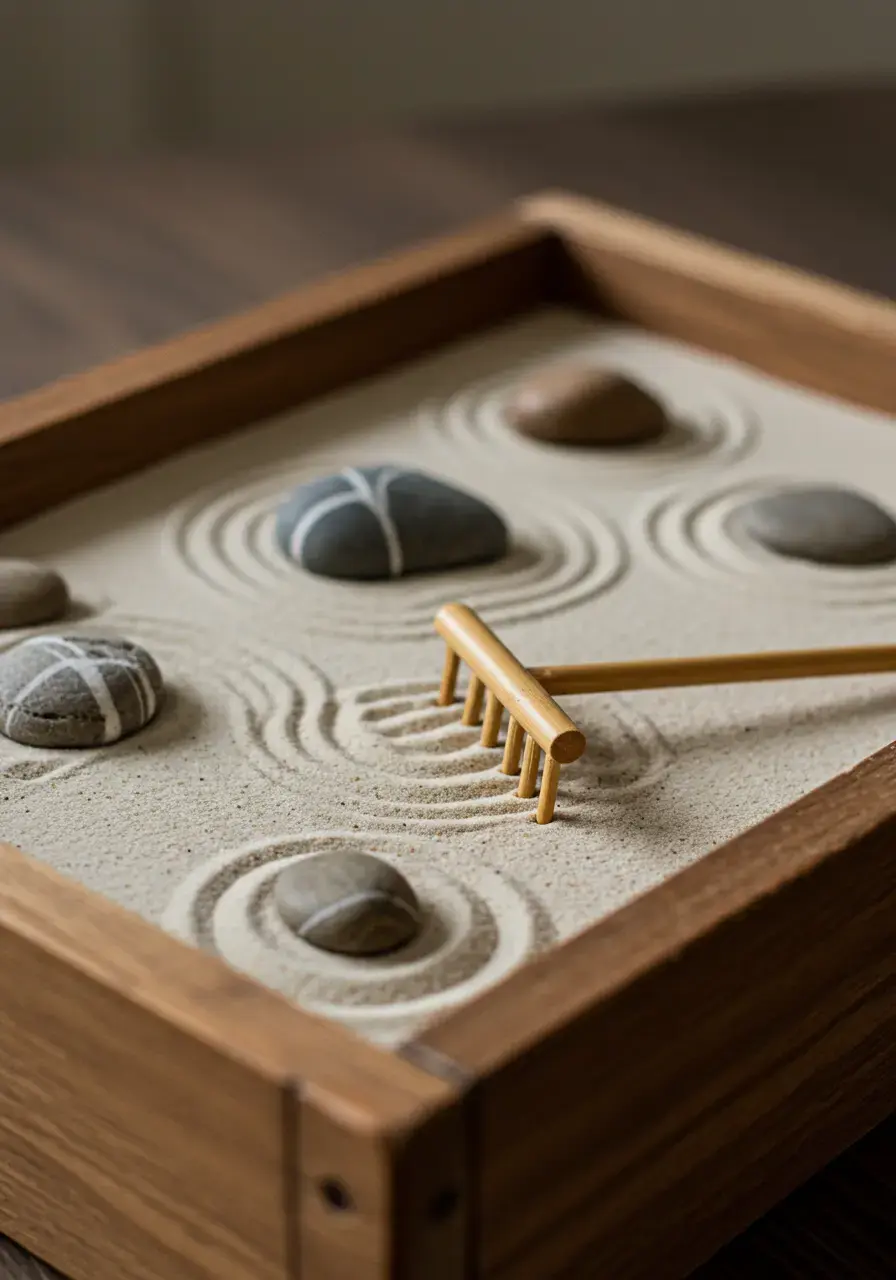
Why This Works:
DIY projects foster a deeper connection to the item, making your Zen garden more personal and meaningful. It’s a cost-effective way to create a bespoke piece that perfectly fits your aesthetic, and the act of creation itself can be very meditative and rewarding.
How You Can Recreate It:
- Repurpose an old wooden box or a ceramic platter as your base.
- Use craft sand or fine playground sand.
- Collect unique pebbles or small smooth stones from nature walks to personalize it.
Zen Garden Sand Patterns for Calm
One of the most meditative aspects of a Zen garden for me is creating the sand patterns. The repetitive motion of the rake, the way the lines appear and disappear, it’s all incredibly calming. It’s a simple ritual that cleanses my mind. Zen garden sand patterns for calm aren’t just aesthetic; they are an active part of the meditative practice, helping to quiet the mind through focused, repetitive movement.
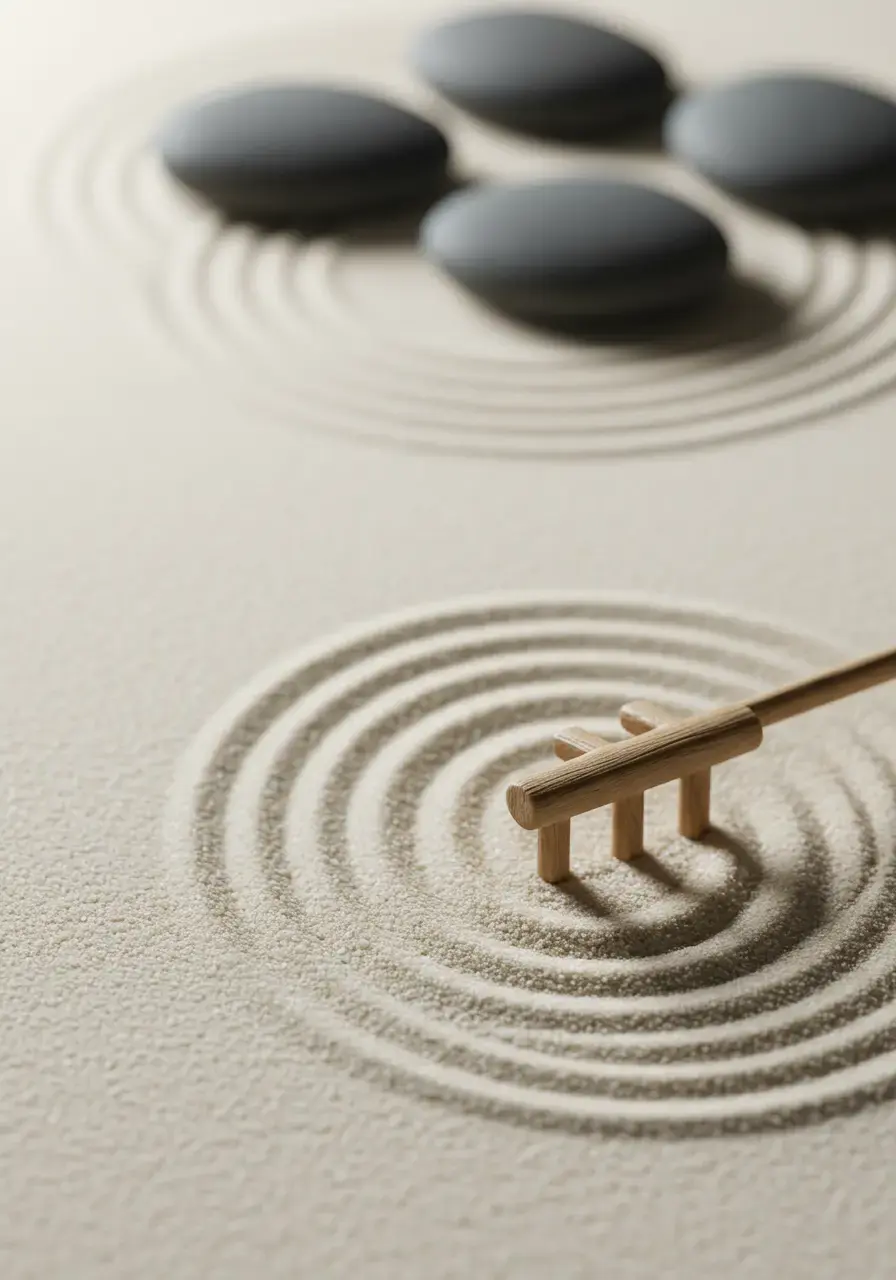
Why This Works:
Creating sand patterns is a direct, hands-on meditative act. The repetitive motion helps clear the mind, reduce stress, and improve focus. Visually, the patterns symbolize water, ripples, or currents, adding dynamic energy and flow to the garden’s static elements.
How You Can Recreate It:
- Invest in a good quality miniature Zen garden rake with various tooth patterns.
- Experiment with different raking techniques—straight lines, concentric circles, or gentle waves.
- Practice daily, allowing the process to become a mindful ritual.
Add Stones and Rocks to Your Zen Garden
Stones and rocks are the backbone of any Zen garden for me. They represent islands, mountains, or even ancient wisdom. When I arrange them, I think about balance and stillness. Each stone has its own character, and placing them thoughtfully brings a sense of groundedness to the garden. Adding stones and rocks to your Zen garden is crucial for creating visual anchors and symbolic meaning within your tranquil space.

Why This Works:
Stones and rocks provide permanent, grounding elements that symbolize mountains or islands, representing stability and strength. Their natural shapes and textures provide a contrast to the smooth sand, adding visual interest and depth to the garden.
How You Can Recreate It:
- Select smooth, naturally shaped stones of varying sizes and colors.
- Arrange them in odd numbers (e.g., 3, 5, 7) for a natural, asymmetrical balance.
- Consider the principle of ‘grouping’ where two or three stones are placed closely together.
Plant Selection for a Tranquil Space
While traditional Zen gardens are often very sparse, I’ve found that a few carefully chosen plants can really soften the edges and add a touch of living vibrancy. My Japanese maple, for example, is a constant source of joy, especially as its leaves change with the seasons. Plant selection for a tranquil space should focus on varieties that contribute to the calming aesthetic without overwhelming it.
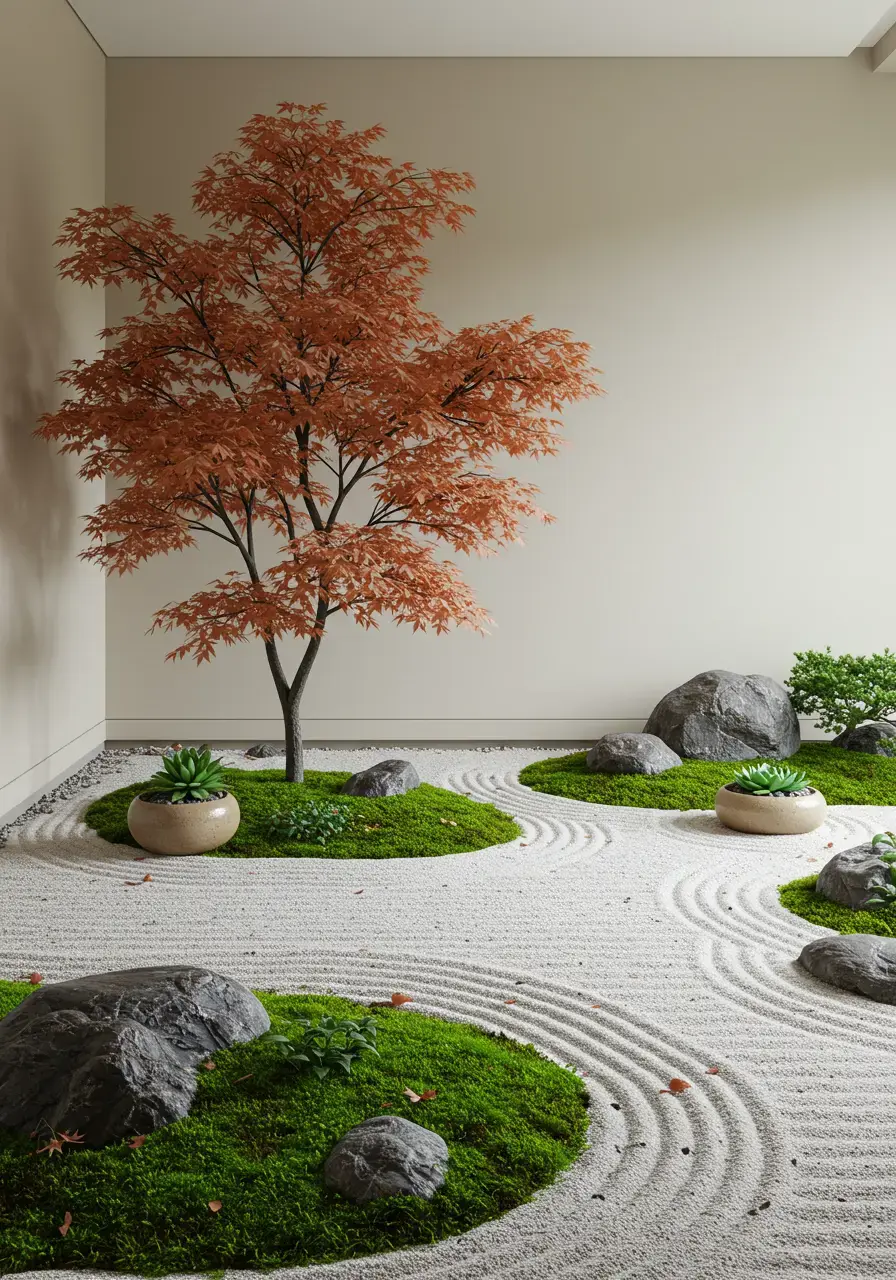
Why This Works:
Plants introduce living elements and natural color, softening the hard lines of stones and sand. They add a sense of growth and renewal, and certain plants, like moss or small evergreen shrubs, are ideal for their low maintenance and serene appearance.
How You Can Recreate It:
- Choose low-maintenance plants like moss, succulents, small ferns, or dwarf conifers.
- Avoid overly flashy or colorful plants that might distract from the garden’s calm focus.
- Place plants strategically to complement the stones and sand, not to dominate the view.
Finding the Perfect Zen Garden Location
Location, location, location! Just like any design element, where you place your Zen garden makes a huge difference. My outdoor garden is tucked away in a quiet corner where I can hear the birds, while my indoor one sits next to a window with good natural light. Finding the perfect Zen garden location is about identifying a spot that naturally invites peace and contemplation.
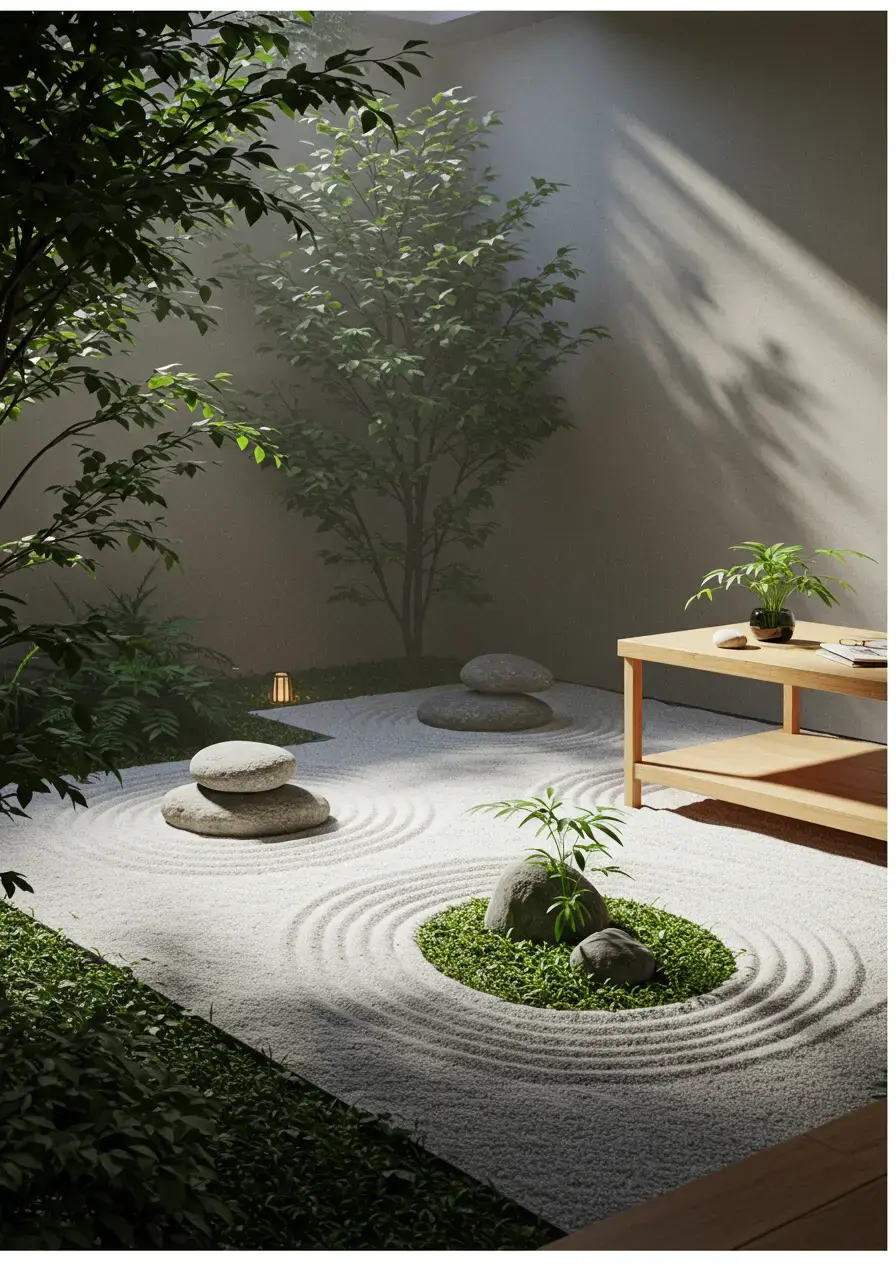
Why This Works:
The right location enhances the garden’s ability to provide tranquility by minimizing distractions and maximizing exposure to natural light or peaceful views. It integrates the garden seamlessly into your living space, making it a natural part of your daily routine for relaxation.
How You Can Recreate It:
- For outdoor gardens, choose a quiet, semi-shaded spot away from high-traffic areas.
- For indoor gardens, place it near a window for natural light, but avoid direct, harsh sunlight.
- Consider accessibility – you want to be able to easily interact with and maintain your garden.
Small Zen Garden Design Essentials
I love tackling small spaces because they challenge me to be super thoughtful about every single element. With a small Zen garden, less is definitely more. Every stone, every rake line, has to earn its place. Small Zen garden design essentials focus on maximizing impact through simplicity, making sure each component serves a purpose in creating a peaceful miniature world.
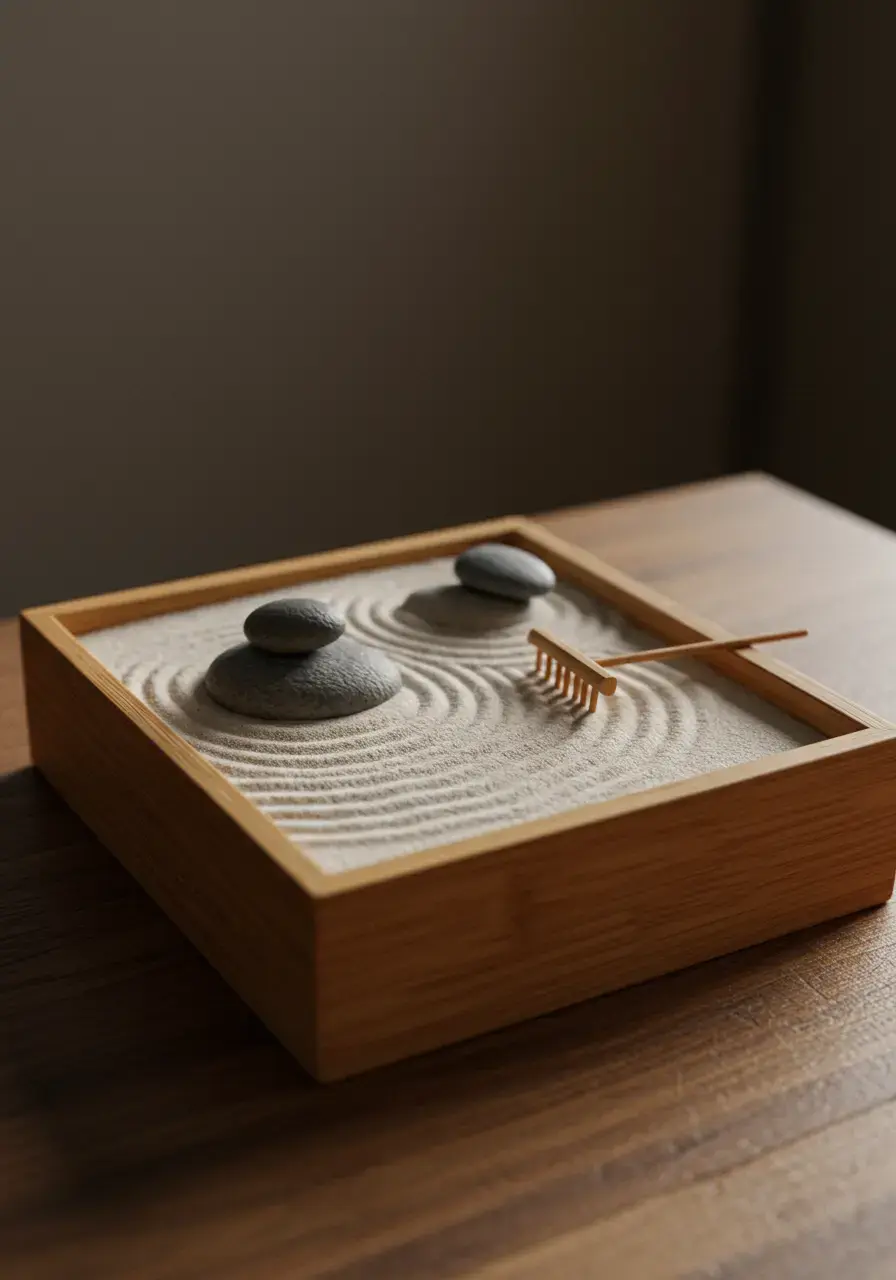
Why This Works:
Focusing on essentials in small designs forces clarity and intentionality, leading to a highly refined and impactful space. It proves that tranquility doesn’t require grand scale; a well-designed small garden can be just as potent a source of calm.
How You Can Recreate It:
- Limit the number of elements to just sand, 1-3 stones, and a tiny rake.
- Use a compact, well-proportioned tray or bowl as your base.
- Choose miniature versions of plants or water features if you wish to include them.
Create a Meditative Outdoor Space
My outdoor Zen garden has become my personal meditation zone. Stepping into it, surrounded by the quiet hum of nature, helps me recenter. It’s truly a place where I can breathe deeply and let go of worries. Creating a meditative outdoor space isn’t just about the visual; it’s about fostering an environment that encourages quiet introspection and relaxation.
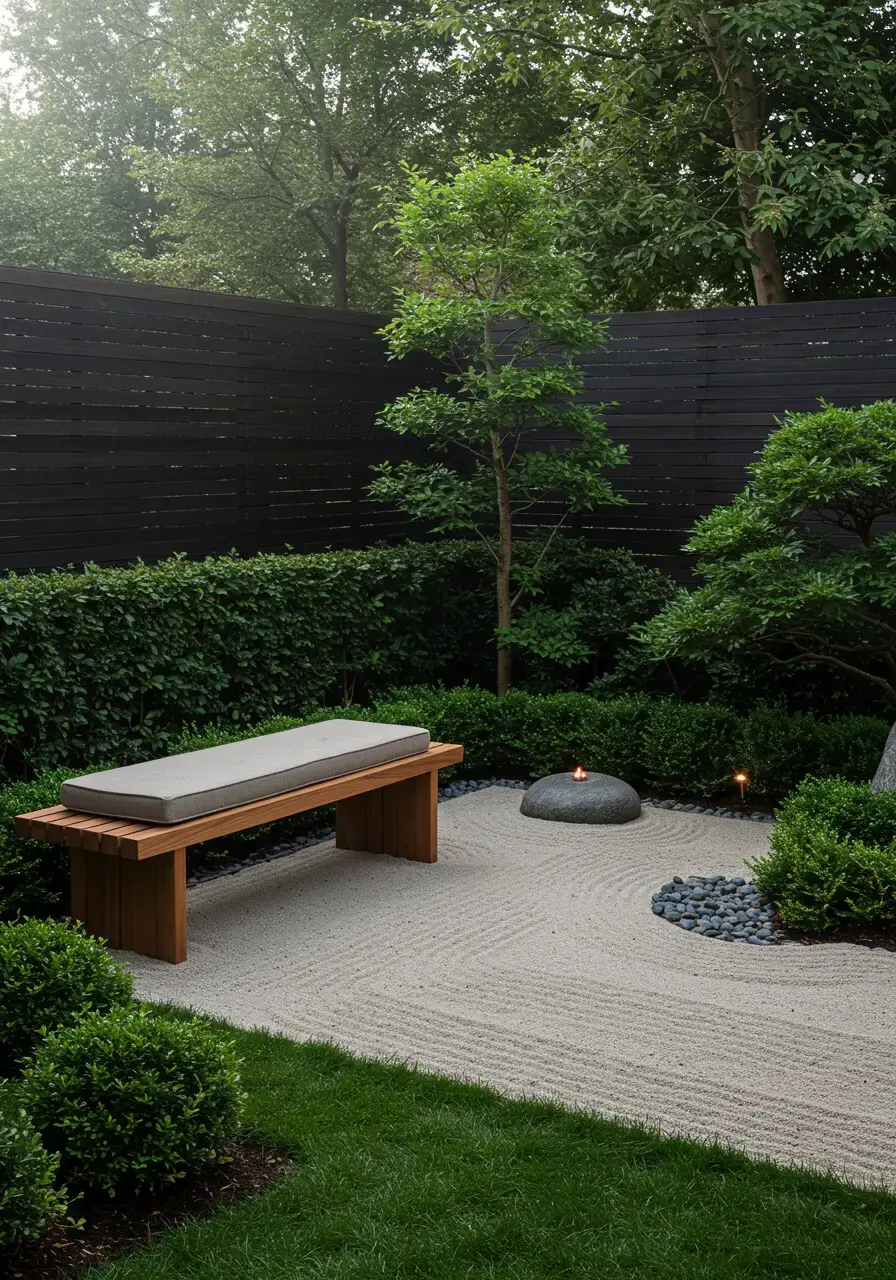
Why This Works:
An outdoor meditative space connects you to nature, providing fresh air and fostering a deeper sense of calm. It offers a dedicated sanctuary away from indoor distractions, allowing for more profound moments of contemplation and relaxation.
How You Can Recreate It:
- Designate a quiet corner of your yard or patio for your garden.
- Consider adding comfortable seating nearby, like a simple bench or cushion.
- Shield it from direct views if possible, with a small screen or natural hedging, to enhance privacy.
Indoor Zen Garden for Serenity
When the weather isn’t cooperating, or I just need a quick pick-me-up during my workday, my indoor Zen garden is a lifesaver. It’s a constant reminder to pause and recenter, right there in my living room. An indoor Zen garden for serenity brings the calming principles of traditional Zen design directly into your home, offering a year-round source of peace regardless of the outside world.
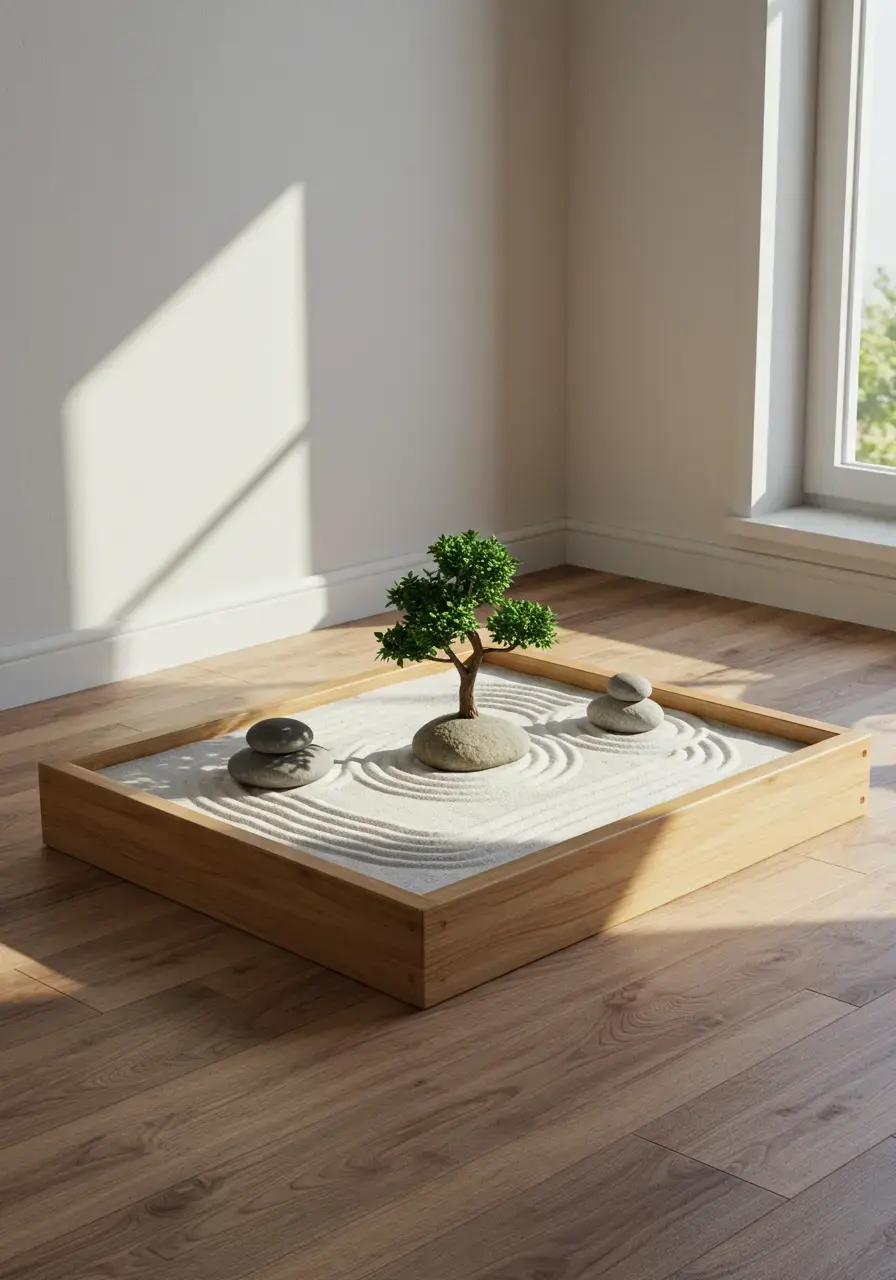
Why This Works:
An indoor Zen garden provides accessibility to tranquility at any time, in any weather. It acts as a constant visual cue for mindfulness and can effectively define a zone of calm within a busy living space.
How You Can Recreate It:
- Choose a location prominent enough to be seen but not in a high-traffic area.
- Ensure it receives adequate indirect light if you include live plants.
- Keep it clean and free of clutter to maintain its serene aesthetic.
Lighting Enhances Your Zen Garden
Lighting can completely transform the mood of a space, and a Zen garden is no exception. I love how a soft glow at dusk can make the sand patterns feel even more enchanting, creating an almost magical atmosphere. Lighting enhances your Zen garden by extending its usability into the evening hours and adding a layer of sophisticated drama and charm.

Why This Works:
Strategic lighting extends the enjoyment of your Zen garden beyond daylight hours, creating a new atmosphere—from mystical to serene. It highlights textures and focal points, adding depth and visual interest after dark.
How You Can Recreate It:
- Use subtle, low-voltage LED lights to softly illuminate key features like stones or small plants.
- Consider solar-powered path lights if it’s an outdoor garden.
- Avoid harsh, bright lights; aim for a soft, ambient glow to maintain tranquility.
Minimalist Zen Garden Principles
I’ve always been drawn to minimalism, and for me, Zen gardens are the epitome of this design philosophy. It’s about stripping away the non-essential to reveal the true beauty and purpose. My own Zen garden journey reinforced that less truly is more, often leading to a profound sense of peace. Minimalist Zen garden principles guide you to create a design that is clean, uncluttered, and deeply impactful.
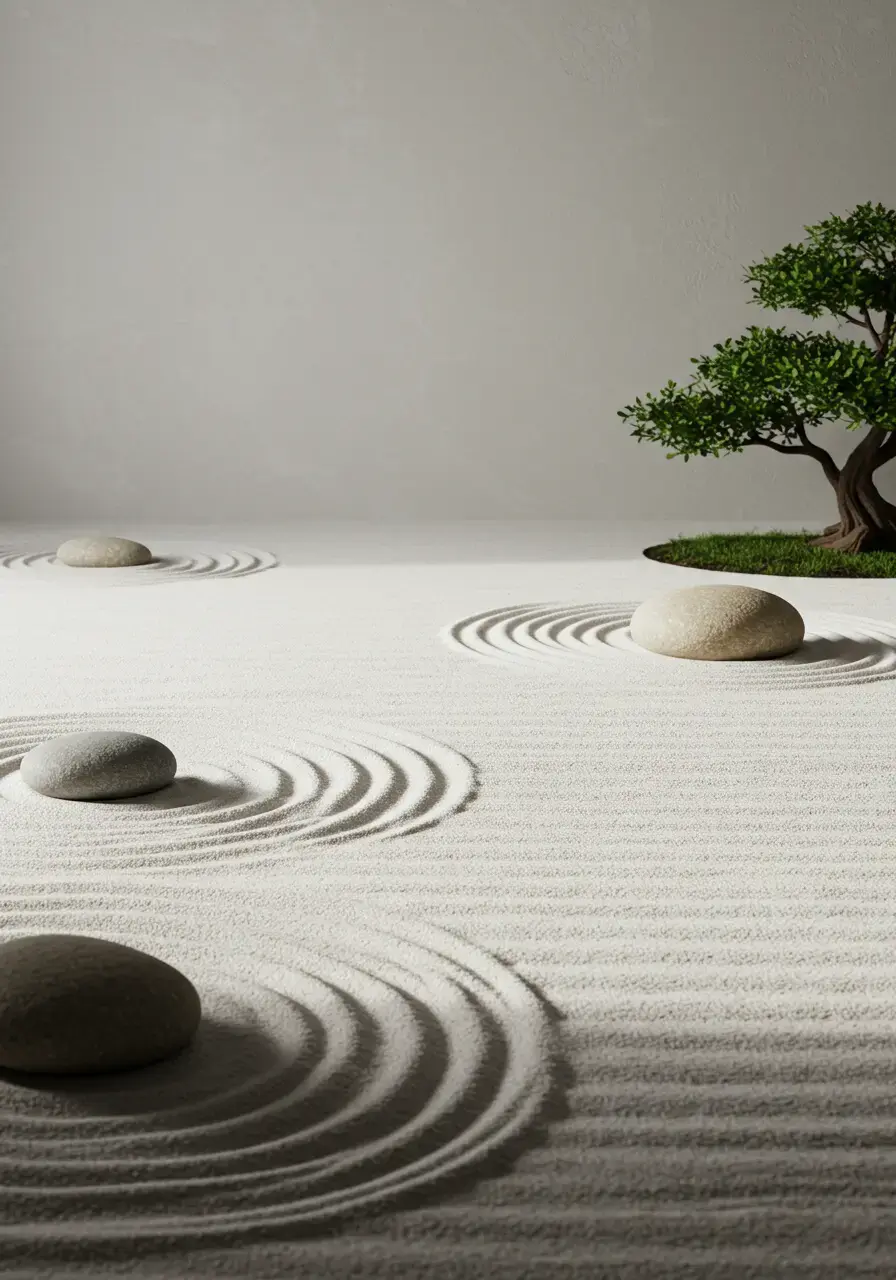
Why This Works:
Minimalism emphasizes simplicity and focuses on essential elements, preventing clutter and distraction. This clarity directly supports the goal of tranquility and mindfulness by offering a clean visual field for contemplation.
How You Can Recreate It:
- Strictly limit the number of elements: focus on sand, a few well-placed stones, and perhaps one small plant.
- Maintain clear, open spaces within the garden.
- Choose neutral colors and natural materials to maintain a cohesive, understated look.
Adding Sculptures to Your Zen Garden
While the core of Zen is often natural elements, I’ve found that a small, carefully chosen sculpture can add a beautiful focal point and a touch of personal expression. For me, a tiny Buddha statue brings a sense of peace and wisdom to my garden. Adding sculptures to your Zen garden provides an opportunity to introduce symbolic meaning or artistic flair, enhancing its meditative quality.
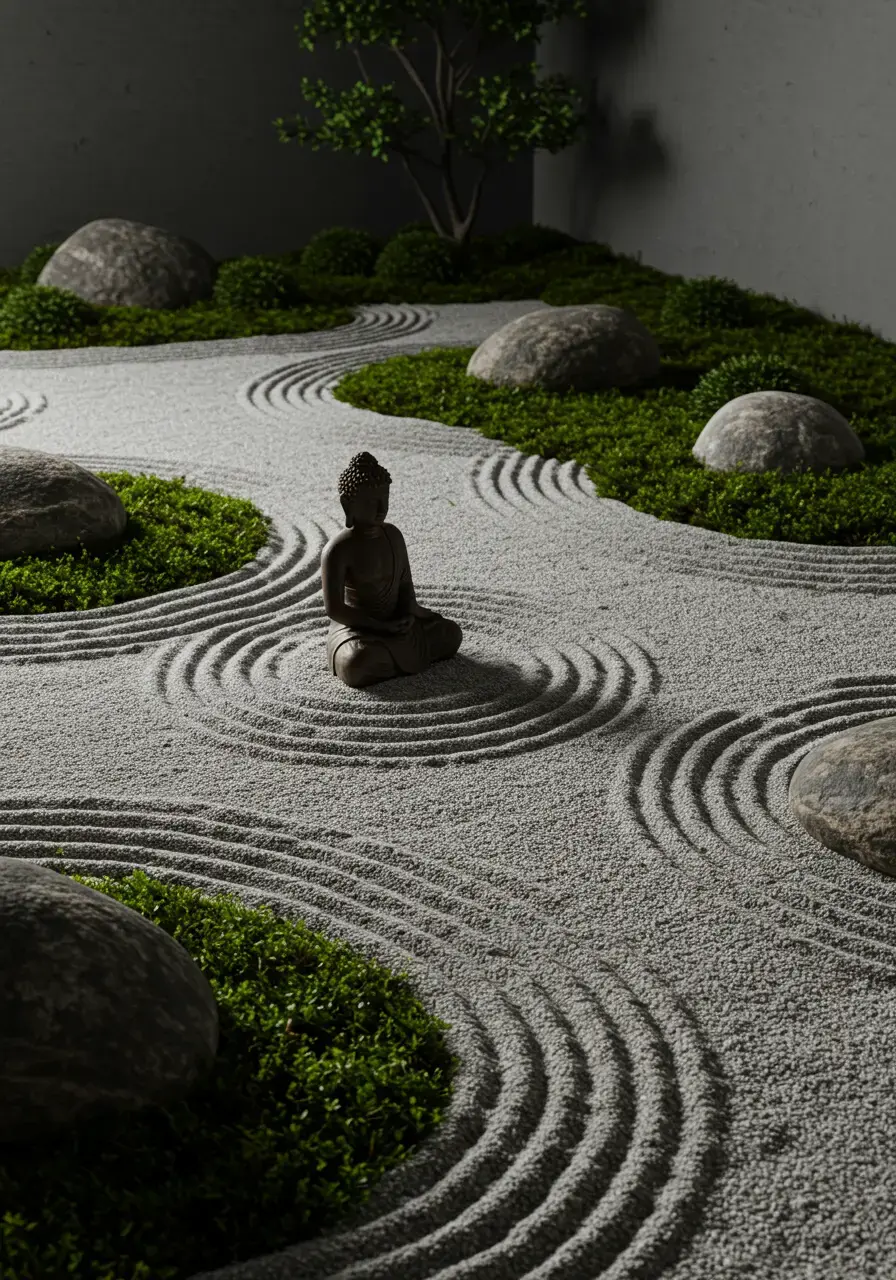
Why This Works:
Sculptures can act as powerful focal points, drawing the eye and providing a point for contemplation. They can also introduce symbolic meaning (like a Buddha or a pagoda), deepening the garden’s spiritual connection and personal resonance.
How You Can Recreate It:
- Choose sculptures that are small, understated, and made of natural materials like stone, ceramic, or bronze.
- Ensure the sculpture complements the serene aesthetic rather than overpowering it.
- Think about its placement – perhaps partially hidden amongst stones or at the edge of the raked sand.
Maintain Your Zen Garden Daily Rituals
The true magic of a Zen garden isn’t just in its creation, but in its daily upkeep. Raking the sand, repositioning a stone – these small acts have become my personal rituals of reflection. It’s like sweeping away the mental dust. Maintain your Zen garden daily rituals to transform it from a static display into a living practice of mindfulness and continuous peace.
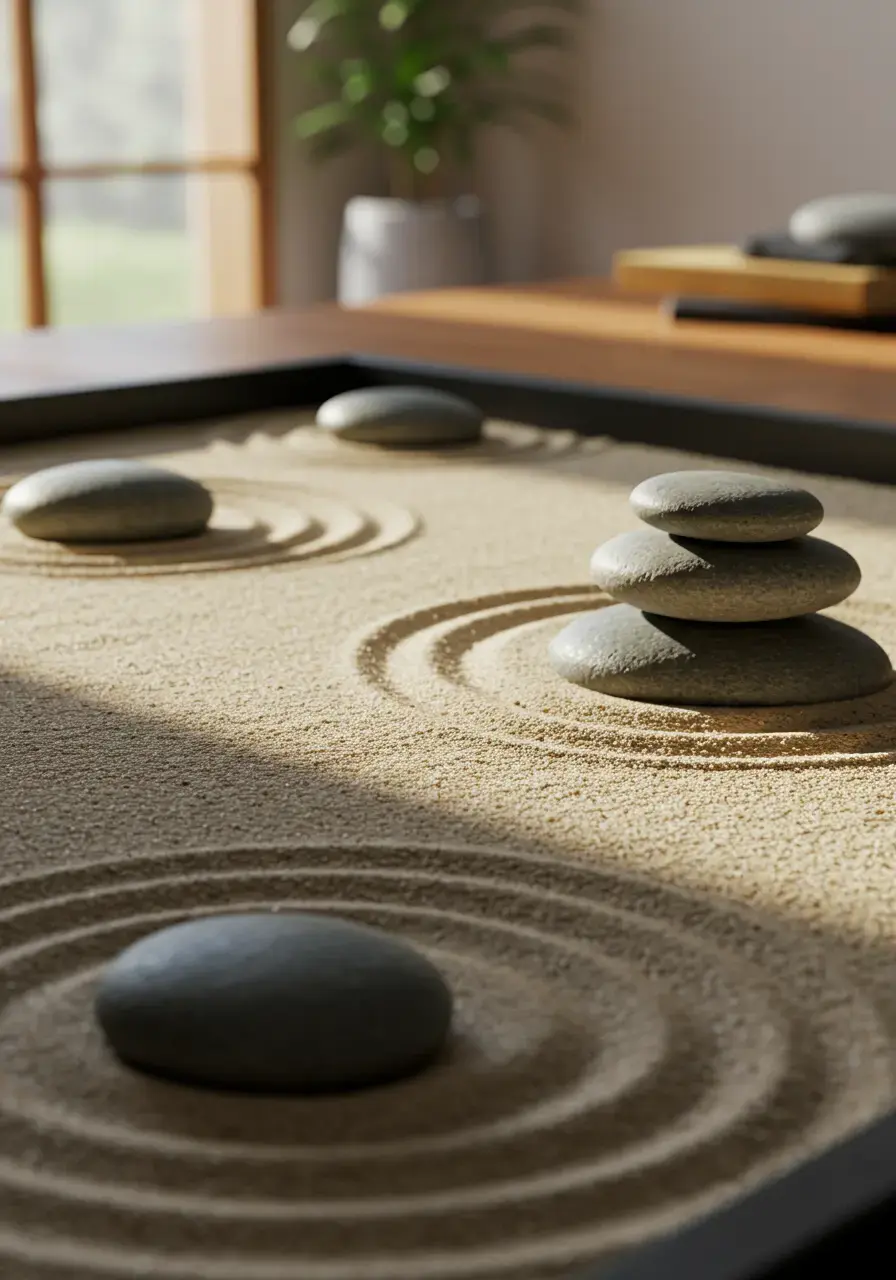
Why This Works:
Daily maintenance fosters a routine of mindfulness and interaction with your garden, reinforcing its purpose as a tool for meditation and stress reduction. It deepens your connection to the space and ensures its perpetual state of beauty and readiness for contemplation.
How You Can Recreate It:
- Dedicate a few minutes each day to gently rake the sand, smoothing out old patterns or creating new ones.
- Periodically clean stones and surfaces to keep them pristine.
- View maintenance not as a chore, but as an opportunity for peaceful reflection and focused presence.
Conclusion
Transforming your home into a sanctuary doesn’t have to be a huge undertaking. My journey with Zen gardens, from tiny tabletop versions to a more expansive outdoor retreat, has shown me that true peace often resides in the simplest of gestures and the most understated of designs. Each idea, from raking sand patterns to adding a gentle water feature, contributes to an overall feeling of calm and balance. Remember, your Zen garden isn’t just a collection of elements; it’s a reflection of your intention to invite serenity into your life. So, take a deep breath, pick an idea that resonates with you, and start creating your own slice of quiet paradise. I promise, moments of tranquil reflection are within your grasp!


